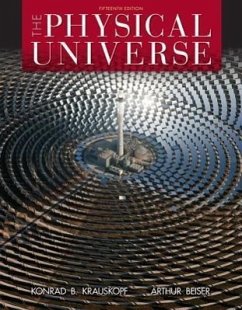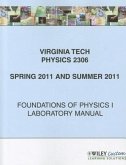- Broschiertes Buch
- Merkliste
- Auf die Merkliste
- Bewerten Bewerten
- Teilen
- Produkt teilen
- Produkterinnerung
- Produkterinnerung
The Physical Universe, 15e by Konrad Krauskopf and Arthur Beiser is an outstanding text with a long history that has been updated and given a fresh look. This edition is also accompanied by a strong media component with the Connect online homework system, personal response system ("clicker") questions, more extensive online quizzing, and PowerPoint lectures. Aimed at presenting the essentials of physics, chemistry, earth science, and astronomy in a clear, easy-to-understand way, The Physical Universe shows students how science works, how scientists approach problems, and why science constantly…mehr
Andere Kunden interessierten sich auch für
![Integrated Science Integrated Science]() Bill W. TilleryIntegrated Science165,99 €
Bill W. TilleryIntegrated Science165,99 €![Physics of the Future Physics of the Future]() Michio KakuPhysics of the Future18,99 €
Michio KakuPhysics of the Future18,99 €![Collision Processes Involving Highly Excited Atoms and Neutral Particles Collision Processes Involving Highly Excited Atoms and Neutral Particles]() V. S. LebedevCollision Processes Involving Highly Excited Atoms and Neutral Particles82,99 €
V. S. LebedevCollision Processes Involving Highly Excited Atoms and Neutral Particles82,99 €![Atom Vibrations in Solids: Amplitudes and Frequencies Atom Vibrations in Solids: Amplitudes and Frequencies]() V. V. LevitinAtom Vibrations in Solids: Amplitudes and Frequencies62,99 €
V. V. LevitinAtom Vibrations in Solids: Amplitudes and Frequencies62,99 €![Virginia Tech Physics 2306: Foundations of Physics I Laboratory Manual for Spring 2011 and Summer 2011 Sessions Virginia Tech Physics 2306: Foundations of Physics I Laboratory Manual for Spring 2011 and Summer 2011 Sessions]() Virginia Tech Physics 2306: Foundations of Physics I Laboratory Manual for Spring 2011 and Summer 2011 Sessions67,99 €
Virginia Tech Physics 2306: Foundations of Physics I Laboratory Manual for Spring 2011 and Summer 2011 Sessions67,99 €![The Age of the Earth The Age of the Earth]() G Brent DalrympleThe Age of the Earth47,99 €
G Brent DalrympleThe Age of the Earth47,99 €![Pearson Physics for the IB Diploma Higher Level Pearson Physics for the IB Diploma Higher Level]() Chris HamperPearson Physics for the IB Diploma Higher Level87,99 €
Chris HamperPearson Physics for the IB Diploma Higher Level87,99 €-
-
-
The Physical Universe, 15e by Konrad Krauskopf and Arthur Beiser is an outstanding text with a long history that has been updated and given a fresh look. This edition is also accompanied by a strong media component with the Connect online homework system, personal response system ("clicker") questions, more extensive online quizzing, and PowerPoint lectures. Aimed at presenting the essentials of physics, chemistry, earth science, and astronomy in a clear, easy-to-understand way, The Physical Universe shows students how science works, how scientists approach problems, and why science constantly evolves in its search for understanding. The text can also be packaged with its long time companion student study guide, which includes a review of chapter terms and concepts; self quizzing for extra practice; and additional solved problems.
Hinweis: Dieser Artikel kann nur an eine deutsche Lieferadresse ausgeliefert werden.
Hinweis: Dieser Artikel kann nur an eine deutsche Lieferadresse ausgeliefert werden.
Produktdetails
- Produktdetails
- Verlag: McGraw-Hill Education
- Revised
- Seitenzahl: 752
- Erscheinungstermin: 22. Januar 2013
- Englisch
- Abmessung: 274mm x 213mm x 30mm
- Gewicht: 1474g
- ISBN-13: 9780073513928
- ISBN-10: 007351392X
- Artikelnr.: 37041418
- Herstellerkennzeichnung
- Libri GmbH
- Europaallee 1
- 36244 Bad Hersfeld
- 06621 890
- Verlag: McGraw-Hill Education
- Revised
- Seitenzahl: 752
- Erscheinungstermin: 22. Januar 2013
- Englisch
- Abmessung: 274mm x 213mm x 30mm
- Gewicht: 1474g
- ISBN-13: 9780073513928
- ISBN-10: 007351392X
- Artikelnr.: 37041418
- Herstellerkennzeichnung
- Libri GmbH
- Europaallee 1
- 36244 Bad Hersfeld
- 06621 890
Konrad B. Krauskopf was born and raised in Madison, Wisconsin and earned a B.S. in chemistry from University of Wisconsin in 1931. He then earned a Ph.D. in chemistry at the University of California in Berkeley. When the Great Depression made jobs in chemistry scarce, Professor Krauskopf decided to study geology, which had long fascinated him. Through additional graduate work at Stanford University, he earned a second Ph.D. and eventually a position on the Stanford faculty. He remained at Stanford until his retirement in 1976. During his tenure, Professor Krauskopf also worked at various times with the U.S. Geological Survey, served with the U.S. army in occupied Japan, and traveled to Norway, France, and Germany on sabbatical leaves. His research interests included field work on granites and metamorphic rocks and laboratory study on applications of chemistry to geologic problems, especially the formation of ore deposits. In recent years, Professor Krauskopf had spent time working with various government agencies on the problem of radioactive waste disposal.
1 The Scientific MethodHow Scientists Study Nature1.1 The Scientific
Method1.2 Why Science Is SuccessfulThe Solar System1.3 A Survey of the
Sky1.4 The Ptolemaic System1.5 The Copernican System1.6 Kepler's Laws1.7
Why Copernicus Was RightUniversal Gravitation1.8 What Is Gravity?1.9 Why
the Earth Is Round1.10 The Tides1.11 The Discovery of NeptuneHow Many of
What1.12 The SI System2 MotionDescribing Motion2.1 Speed2.2 Vectors2.3
Acceleration2.4 Distance, Time, and AccelerationAcceleration due to
Gravity2.5 Free Fall2.6 Air ResistanceForce and Motion2.7 First law of
Motion2.8 Mass2.9 Second law of Motion2.10 Mass and Weight2.11 Third law of
MotionGravitation2.12 Circular Motion2.13 Newton's Law of Gravity2.14
Artificial Satellites3 EnergyWork3.1 The Meaning of Work3.2 PowerEnergy3.3
Kinetic Energy3.4 Potential Energy3.5 Energy Transformations3.6
Conservation of Energy3.7 The Nature of HeatMomentum3.8 Linear Momentum3.9
Rockets3.10 Angular MomentumRelativity3.11 Special Relativity3.12 Rest
Energy3.13 General RelativityEnergy and Civilization3.14 The Energy
Problem3.15 The Future4 Energy and the FutureThe Energy Problem4.1
Population and Prosperity4.2 Energy Consumption4.3 Global Warming4.4 Carbon
Dioxide and the Greenhouse EffectFossil Fuels4.5 Liquid Fuels4.6 Natural
Gas4.7 CoalAlternative Sources4.8 A Nuclear World?4.9 Clean Energy I4.10
Clean Energy II4.11 Energy Storage4.12 BiofuelsStrategies for the
Future4.13 Conservation4.14 What Governments Must Do5 Matter and
HeatTemperature and Heat5.1 Temperature5.2 Heat5.3 Metabolic
EnergyFluids5.4 Density5.5 Pressure5.6 Buoyancy5.7 Gas LawsKinetic Theory
of Matter5.8 Kinetic Theory of Gases5.9 Molecular Motion and
TemperatureChanges of State5.10 Heat Transfer5.11 Liquids and Solids5.12
Evaporation and Boiling5.13 MeltingEnergy Transformations5.14 Heat
Engines5.15 Thermodynamics5.16 Fate of the Universe5.17 Entropy6
Electricity and MagnetismElectric Charge6.1 Positive and Negative Charge6.2
What Is Charge?6.3 Coulomb's Law6.4 Force on an Uncharged ObjectElectricity
and Matter6.5 Matter in Bulk6.6 Conductors and Insulators6.7
SuperconductivityElectric Current6.8 The Ampere6.9 Potential Difference6.10
Ohm's Law6.11 Electric PowerMagnetism6.12 Magnets6.13 Magnetic Field6.14
Oersted's Experiment6.15 ElectromagnetsUsing Magnetism6.16 Magnetic Force
on a Current6.17 Electric Motors6.18 Electromagnetic Induction6.19
Transformers7 WavesWave Motion7.1 Water Waves7.2 Transverse and
Longitudinal Waves7.3 Describing Waves7.4 Standing WavesSound Waves7.5
Sound7.6 Doppler Effect7.7 Musical SoundsElectromagnetic Waves7.8
Electromagnetic Waves7.9 Types of EM Waves7.10 Light "Rays"Wave
Behavior7.11 Reflection7.12 Refraction7.13 Lenses7.14 The Eye7.15 Color7.16
Interference7.17 Diffraction8 The NucleusAtom and Nucleus8.1 Rutherford
Model of the Atom8.2 Nuclear StructureRadioactivity8.3 Radioactive Decay8.4
Half-Life8.5 Radiation HazardsNuclear Energy8.6 Units of Mass and Energy8.7
Binding Energy8.8 Binding Energy per NucleonFission and Fusion8.9 Nuclear
Fission8.10 How a Reactor Works8.11 Plutonium8.12 A Nuclear World?8.13
Nuclear FusionElementary Particles8.14 Antiparticles8.15 Fundamental
Interactions8.16 Leptons and Hadrons9 The AtomQuantum Theory of Light9.1
Photoelectric Effect9.2 Photons9.3 What Is Light?9.4 X-RaysMatter Waves9.5
De Broglie9.6 Waves of What?9.7 Uncertainty PrincipleThe Hydrogen Atom9.8
Atomic Spectra9.9 The Bohr Model9.10 Electron Waves and Orbitals9.11 The
LaserQuantum Theory of the Atom9.12 Quantum Mechanics9.13 Quantum
Numbers9.14 Exclusion Principle10 The Periodic LawElements and
Compounds10.1 Chemical Change10.2 Three Classes of Matter10.3 The Atomic
TheoryThe Periodic Law10.4 Metals and Nonmetals10.5 Chemical Activity10.6
Families of Elements10.7 The Periodic Table10.8 Groups and PeriodsAtomic
Structure10.9 Shells and Subshells10.10 Explaining the Periodic
TableChemical Bonds10.11 Types of Bond10.12 Covalent Bonding10.13 Ionic
Bonding10.14 Ionic Compounds10.15 Atoms Groups10.16 Naming Compounds10.17
Chemical Equations11 Crystals, Ions, and SolutionsSolids11.1 Ionic and
Covalent Crystals11.2 The Metallic Bond11.3 Molecular CrystalsSolutions11.4
Solubility11.5 Polar and Nonpolar Liquids11.6 Ions in Solution11.7 Evidence
for Dissociation11.8 Water11.9 Water PollutionAcids and Bases11.10
Acids11.11 Strong and Weak Acids11.12 Bases11.13 The pH Scale11.14 Salts12
Chemical ReactionsQuantitative Chemistry12.1 Phlogiston12.2 Oxygen12.3 The
Mole12.4 Formula UnitsChemical Energy12.5 Exothermic and Endothermic
Reactions12.6 Chemical Energy and Stability12.7 Activation energyFuels12.8
Liquid Fuels12.9 Gas Fuels12.10 Solid FuelsReaction Rates12.11
Temperature12.12 Other Factors12.13 Chemical Equilibrium12.14 Altering an
EquilibriumOxidation and Reduction12.15 Electrolysis12.16 Electrochemical
cells13 Organic ChemistryCarbon Compounds13.1 Carbon Bonds13.2 Alkanes13.3
Petroleum ProductsStructures of Organic Molecules13.4 Structural
Formulas13.5 Isomers13.6 Unsaturated Hydrocarbons13.7 BenzeneOrganic
Compounds13.8 Hydrocarbon Groups13.9 Functional Groups13.10
PolymersChemistry of Life13.11 Carbohydrates13.12 Photosynthesis13.13
Lipids13.14 Proteins13.15 Soil Nitrogen13.16 Nucleic Acids13.17 Origin of
Life14 Atmosphere and HydrosphereThe Atmosphere14.1 Regions of the
Atmosphere14.2 Atmospheric Moisture14.3 CloudsWeather14.4 Atmospheric
Energy14.5 The Seasons14.6 Winds14.7 General Circulation of the
Atmosphere14.8 Middle-Latitude Weather SystemsClimate14.9 Tropical
Climates14.10 Middle- and High-Latitude Climates14.11 Climatic Changes14.12
Origins of Climatic ChangeThe Hydrosphere14.13 Ocean Basins14.14 Ocean
Currents15 The Rock CycleRocks15.1 Composition of the Crust15.2
Minerals15.3 Igneous Rocks15.4 Sedimentary Rocks15.5 Metamorphic
RocksWithin the Earth15.6 Earthquakes15.7 Structure of the Earth15.8 The
Earth's Interior15.9 GeomagnetismErosion15.10 Weathering15.11 Stream
Erosion15.12 Glaciers15.13 Groundwater15.14 SedimentationVulcanism15.15
Volcanoes15.16 Intrusive Rocks15.17 The Rock Cycles16 The Evolving
EarthTectonic Movement16.1 Types of Movement16.2 Mountain Building16.3
Continental DriftPlate Tectonics16.4 Lithosphere and Asthenosphere16.5 The
Ocean Floors16.6 Ocean-Floor Spreading16.7 Plate TectonicsMethods of
Historical Geology16.8 Principles of Uniform Change16.9 Rock
Formations16.10 Radiometric Dating16.11 Fossils16.12 Geologic TimeEarth
History16.13 Precambrian Time16.14 The Paleozoic Era16.15 Coal and
Petroleum16.16 The Mesozoic Era16.17 The Cenozoic Era16.18 Human History17
The Solar SystemThe Family of the Sun17.1 The Solar System17.2 Comets17.3
MeteorsThe Inner Planets17.4 Mercury17.5 Venus17.6 Mars17.7 Is There Life
On Mars?17.8 AsteroidsThe Outer Planets17.9 Jupiter17.10 Saturn17.11
Uranus, Neptune, PlutoThe Moon17.12 Phases17.13 Eclipses17.14 Lunar Surface
and Interior17.15 Evolution of the Lunar Landscape17.16 Origin of the
Moon18 The StarsTools of Astronomy18.1 The Telescope18.2 The
Spectrometer18.3 Spectrum AnalysisThe Sun18.4 Properties of the Sun18.5 The
Aurora18.6 Sunspots18.7 Solar EnergyThe Stars18.8 Stellar Distances18.9
Variable Stars18.10 Stellar Motions18.11 Stellar PropertiesLife Histories
of the Stars18.12 H-R Diagrams18.13 Stellar Evolution18.14 Supernovas18.15
Pulsars18.16 Black Holes19 The UniverseGalaxies19.1 The Milky Way19.2
Stellar Populations19.3 Radio Astronomy19.4 Galaxies19.5 Cosmic RaysThe
Expanding Universe19.6 Red Shifts19.7 QuasarsEvolution of the Universe19.8
Dating the Universe19.9 After the Big Bang19.10 Origin of the Solar
SystemExtraterrestrial Life19.11 Extrasolar Planets19.12 Interstellar
Travel19.13 Interstellar CommunicationMath RefresherThe ElementsAnswers to
Odd-Numbered Exercises
Method1.2 Why Science Is SuccessfulThe Solar System1.3 A Survey of the
Sky1.4 The Ptolemaic System1.5 The Copernican System1.6 Kepler's Laws1.7
Why Copernicus Was RightUniversal Gravitation1.8 What Is Gravity?1.9 Why
the Earth Is Round1.10 The Tides1.11 The Discovery of NeptuneHow Many of
What1.12 The SI System2 MotionDescribing Motion2.1 Speed2.2 Vectors2.3
Acceleration2.4 Distance, Time, and AccelerationAcceleration due to
Gravity2.5 Free Fall2.6 Air ResistanceForce and Motion2.7 First law of
Motion2.8 Mass2.9 Second law of Motion2.10 Mass and Weight2.11 Third law of
MotionGravitation2.12 Circular Motion2.13 Newton's Law of Gravity2.14
Artificial Satellites3 EnergyWork3.1 The Meaning of Work3.2 PowerEnergy3.3
Kinetic Energy3.4 Potential Energy3.5 Energy Transformations3.6
Conservation of Energy3.7 The Nature of HeatMomentum3.8 Linear Momentum3.9
Rockets3.10 Angular MomentumRelativity3.11 Special Relativity3.12 Rest
Energy3.13 General RelativityEnergy and Civilization3.14 The Energy
Problem3.15 The Future4 Energy and the FutureThe Energy Problem4.1
Population and Prosperity4.2 Energy Consumption4.3 Global Warming4.4 Carbon
Dioxide and the Greenhouse EffectFossil Fuels4.5 Liquid Fuels4.6 Natural
Gas4.7 CoalAlternative Sources4.8 A Nuclear World?4.9 Clean Energy I4.10
Clean Energy II4.11 Energy Storage4.12 BiofuelsStrategies for the
Future4.13 Conservation4.14 What Governments Must Do5 Matter and
HeatTemperature and Heat5.1 Temperature5.2 Heat5.3 Metabolic
EnergyFluids5.4 Density5.5 Pressure5.6 Buoyancy5.7 Gas LawsKinetic Theory
of Matter5.8 Kinetic Theory of Gases5.9 Molecular Motion and
TemperatureChanges of State5.10 Heat Transfer5.11 Liquids and Solids5.12
Evaporation and Boiling5.13 MeltingEnergy Transformations5.14 Heat
Engines5.15 Thermodynamics5.16 Fate of the Universe5.17 Entropy6
Electricity and MagnetismElectric Charge6.1 Positive and Negative Charge6.2
What Is Charge?6.3 Coulomb's Law6.4 Force on an Uncharged ObjectElectricity
and Matter6.5 Matter in Bulk6.6 Conductors and Insulators6.7
SuperconductivityElectric Current6.8 The Ampere6.9 Potential Difference6.10
Ohm's Law6.11 Electric PowerMagnetism6.12 Magnets6.13 Magnetic Field6.14
Oersted's Experiment6.15 ElectromagnetsUsing Magnetism6.16 Magnetic Force
on a Current6.17 Electric Motors6.18 Electromagnetic Induction6.19
Transformers7 WavesWave Motion7.1 Water Waves7.2 Transverse and
Longitudinal Waves7.3 Describing Waves7.4 Standing WavesSound Waves7.5
Sound7.6 Doppler Effect7.7 Musical SoundsElectromagnetic Waves7.8
Electromagnetic Waves7.9 Types of EM Waves7.10 Light "Rays"Wave
Behavior7.11 Reflection7.12 Refraction7.13 Lenses7.14 The Eye7.15 Color7.16
Interference7.17 Diffraction8 The NucleusAtom and Nucleus8.1 Rutherford
Model of the Atom8.2 Nuclear StructureRadioactivity8.3 Radioactive Decay8.4
Half-Life8.5 Radiation HazardsNuclear Energy8.6 Units of Mass and Energy8.7
Binding Energy8.8 Binding Energy per NucleonFission and Fusion8.9 Nuclear
Fission8.10 How a Reactor Works8.11 Plutonium8.12 A Nuclear World?8.13
Nuclear FusionElementary Particles8.14 Antiparticles8.15 Fundamental
Interactions8.16 Leptons and Hadrons9 The AtomQuantum Theory of Light9.1
Photoelectric Effect9.2 Photons9.3 What Is Light?9.4 X-RaysMatter Waves9.5
De Broglie9.6 Waves of What?9.7 Uncertainty PrincipleThe Hydrogen Atom9.8
Atomic Spectra9.9 The Bohr Model9.10 Electron Waves and Orbitals9.11 The
LaserQuantum Theory of the Atom9.12 Quantum Mechanics9.13 Quantum
Numbers9.14 Exclusion Principle10 The Periodic LawElements and
Compounds10.1 Chemical Change10.2 Three Classes of Matter10.3 The Atomic
TheoryThe Periodic Law10.4 Metals and Nonmetals10.5 Chemical Activity10.6
Families of Elements10.7 The Periodic Table10.8 Groups and PeriodsAtomic
Structure10.9 Shells and Subshells10.10 Explaining the Periodic
TableChemical Bonds10.11 Types of Bond10.12 Covalent Bonding10.13 Ionic
Bonding10.14 Ionic Compounds10.15 Atoms Groups10.16 Naming Compounds10.17
Chemical Equations11 Crystals, Ions, and SolutionsSolids11.1 Ionic and
Covalent Crystals11.2 The Metallic Bond11.3 Molecular CrystalsSolutions11.4
Solubility11.5 Polar and Nonpolar Liquids11.6 Ions in Solution11.7 Evidence
for Dissociation11.8 Water11.9 Water PollutionAcids and Bases11.10
Acids11.11 Strong and Weak Acids11.12 Bases11.13 The pH Scale11.14 Salts12
Chemical ReactionsQuantitative Chemistry12.1 Phlogiston12.2 Oxygen12.3 The
Mole12.4 Formula UnitsChemical Energy12.5 Exothermic and Endothermic
Reactions12.6 Chemical Energy and Stability12.7 Activation energyFuels12.8
Liquid Fuels12.9 Gas Fuels12.10 Solid FuelsReaction Rates12.11
Temperature12.12 Other Factors12.13 Chemical Equilibrium12.14 Altering an
EquilibriumOxidation and Reduction12.15 Electrolysis12.16 Electrochemical
cells13 Organic ChemistryCarbon Compounds13.1 Carbon Bonds13.2 Alkanes13.3
Petroleum ProductsStructures of Organic Molecules13.4 Structural
Formulas13.5 Isomers13.6 Unsaturated Hydrocarbons13.7 BenzeneOrganic
Compounds13.8 Hydrocarbon Groups13.9 Functional Groups13.10
PolymersChemistry of Life13.11 Carbohydrates13.12 Photosynthesis13.13
Lipids13.14 Proteins13.15 Soil Nitrogen13.16 Nucleic Acids13.17 Origin of
Life14 Atmosphere and HydrosphereThe Atmosphere14.1 Regions of the
Atmosphere14.2 Atmospheric Moisture14.3 CloudsWeather14.4 Atmospheric
Energy14.5 The Seasons14.6 Winds14.7 General Circulation of the
Atmosphere14.8 Middle-Latitude Weather SystemsClimate14.9 Tropical
Climates14.10 Middle- and High-Latitude Climates14.11 Climatic Changes14.12
Origins of Climatic ChangeThe Hydrosphere14.13 Ocean Basins14.14 Ocean
Currents15 The Rock CycleRocks15.1 Composition of the Crust15.2
Minerals15.3 Igneous Rocks15.4 Sedimentary Rocks15.5 Metamorphic
RocksWithin the Earth15.6 Earthquakes15.7 Structure of the Earth15.8 The
Earth's Interior15.9 GeomagnetismErosion15.10 Weathering15.11 Stream
Erosion15.12 Glaciers15.13 Groundwater15.14 SedimentationVulcanism15.15
Volcanoes15.16 Intrusive Rocks15.17 The Rock Cycles16 The Evolving
EarthTectonic Movement16.1 Types of Movement16.2 Mountain Building16.3
Continental DriftPlate Tectonics16.4 Lithosphere and Asthenosphere16.5 The
Ocean Floors16.6 Ocean-Floor Spreading16.7 Plate TectonicsMethods of
Historical Geology16.8 Principles of Uniform Change16.9 Rock
Formations16.10 Radiometric Dating16.11 Fossils16.12 Geologic TimeEarth
History16.13 Precambrian Time16.14 The Paleozoic Era16.15 Coal and
Petroleum16.16 The Mesozoic Era16.17 The Cenozoic Era16.18 Human History17
The Solar SystemThe Family of the Sun17.1 The Solar System17.2 Comets17.3
MeteorsThe Inner Planets17.4 Mercury17.5 Venus17.6 Mars17.7 Is There Life
On Mars?17.8 AsteroidsThe Outer Planets17.9 Jupiter17.10 Saturn17.11
Uranus, Neptune, PlutoThe Moon17.12 Phases17.13 Eclipses17.14 Lunar Surface
and Interior17.15 Evolution of the Lunar Landscape17.16 Origin of the
Moon18 The StarsTools of Astronomy18.1 The Telescope18.2 The
Spectrometer18.3 Spectrum AnalysisThe Sun18.4 Properties of the Sun18.5 The
Aurora18.6 Sunspots18.7 Solar EnergyThe Stars18.8 Stellar Distances18.9
Variable Stars18.10 Stellar Motions18.11 Stellar PropertiesLife Histories
of the Stars18.12 H-R Diagrams18.13 Stellar Evolution18.14 Supernovas18.15
Pulsars18.16 Black Holes19 The UniverseGalaxies19.1 The Milky Way19.2
Stellar Populations19.3 Radio Astronomy19.4 Galaxies19.5 Cosmic RaysThe
Expanding Universe19.6 Red Shifts19.7 QuasarsEvolution of the Universe19.8
Dating the Universe19.9 After the Big Bang19.10 Origin of the Solar
SystemExtraterrestrial Life19.11 Extrasolar Planets19.12 Interstellar
Travel19.13 Interstellar CommunicationMath RefresherThe ElementsAnswers to
Odd-Numbered Exercises
1 The Scientific MethodHow Scientists Study Nature1.1 The Scientific
Method1.2 Why Science Is SuccessfulThe Solar System1.3 A Survey of the
Sky1.4 The Ptolemaic System1.5 The Copernican System1.6 Kepler's Laws1.7
Why Copernicus Was RightUniversal Gravitation1.8 What Is Gravity?1.9 Why
the Earth Is Round1.10 The Tides1.11 The Discovery of NeptuneHow Many of
What1.12 The SI System2 MotionDescribing Motion2.1 Speed2.2 Vectors2.3
Acceleration2.4 Distance, Time, and AccelerationAcceleration due to
Gravity2.5 Free Fall2.6 Air ResistanceForce and Motion2.7 First law of
Motion2.8 Mass2.9 Second law of Motion2.10 Mass and Weight2.11 Third law of
MotionGravitation2.12 Circular Motion2.13 Newton's Law of Gravity2.14
Artificial Satellites3 EnergyWork3.1 The Meaning of Work3.2 PowerEnergy3.3
Kinetic Energy3.4 Potential Energy3.5 Energy Transformations3.6
Conservation of Energy3.7 The Nature of HeatMomentum3.8 Linear Momentum3.9
Rockets3.10 Angular MomentumRelativity3.11 Special Relativity3.12 Rest
Energy3.13 General RelativityEnergy and Civilization3.14 The Energy
Problem3.15 The Future4 Energy and the FutureThe Energy Problem4.1
Population and Prosperity4.2 Energy Consumption4.3 Global Warming4.4 Carbon
Dioxide and the Greenhouse EffectFossil Fuels4.5 Liquid Fuels4.6 Natural
Gas4.7 CoalAlternative Sources4.8 A Nuclear World?4.9 Clean Energy I4.10
Clean Energy II4.11 Energy Storage4.12 BiofuelsStrategies for the
Future4.13 Conservation4.14 What Governments Must Do5 Matter and
HeatTemperature and Heat5.1 Temperature5.2 Heat5.3 Metabolic
EnergyFluids5.4 Density5.5 Pressure5.6 Buoyancy5.7 Gas LawsKinetic Theory
of Matter5.8 Kinetic Theory of Gases5.9 Molecular Motion and
TemperatureChanges of State5.10 Heat Transfer5.11 Liquids and Solids5.12
Evaporation and Boiling5.13 MeltingEnergy Transformations5.14 Heat
Engines5.15 Thermodynamics5.16 Fate of the Universe5.17 Entropy6
Electricity and MagnetismElectric Charge6.1 Positive and Negative Charge6.2
What Is Charge?6.3 Coulomb's Law6.4 Force on an Uncharged ObjectElectricity
and Matter6.5 Matter in Bulk6.6 Conductors and Insulators6.7
SuperconductivityElectric Current6.8 The Ampere6.9 Potential Difference6.10
Ohm's Law6.11 Electric PowerMagnetism6.12 Magnets6.13 Magnetic Field6.14
Oersted's Experiment6.15 ElectromagnetsUsing Magnetism6.16 Magnetic Force
on a Current6.17 Electric Motors6.18 Electromagnetic Induction6.19
Transformers7 WavesWave Motion7.1 Water Waves7.2 Transverse and
Longitudinal Waves7.3 Describing Waves7.4 Standing WavesSound Waves7.5
Sound7.6 Doppler Effect7.7 Musical SoundsElectromagnetic Waves7.8
Electromagnetic Waves7.9 Types of EM Waves7.10 Light "Rays"Wave
Behavior7.11 Reflection7.12 Refraction7.13 Lenses7.14 The Eye7.15 Color7.16
Interference7.17 Diffraction8 The NucleusAtom and Nucleus8.1 Rutherford
Model of the Atom8.2 Nuclear StructureRadioactivity8.3 Radioactive Decay8.4
Half-Life8.5 Radiation HazardsNuclear Energy8.6 Units of Mass and Energy8.7
Binding Energy8.8 Binding Energy per NucleonFission and Fusion8.9 Nuclear
Fission8.10 How a Reactor Works8.11 Plutonium8.12 A Nuclear World?8.13
Nuclear FusionElementary Particles8.14 Antiparticles8.15 Fundamental
Interactions8.16 Leptons and Hadrons9 The AtomQuantum Theory of Light9.1
Photoelectric Effect9.2 Photons9.3 What Is Light?9.4 X-RaysMatter Waves9.5
De Broglie9.6 Waves of What?9.7 Uncertainty PrincipleThe Hydrogen Atom9.8
Atomic Spectra9.9 The Bohr Model9.10 Electron Waves and Orbitals9.11 The
LaserQuantum Theory of the Atom9.12 Quantum Mechanics9.13 Quantum
Numbers9.14 Exclusion Principle10 The Periodic LawElements and
Compounds10.1 Chemical Change10.2 Three Classes of Matter10.3 The Atomic
TheoryThe Periodic Law10.4 Metals and Nonmetals10.5 Chemical Activity10.6
Families of Elements10.7 The Periodic Table10.8 Groups and PeriodsAtomic
Structure10.9 Shells and Subshells10.10 Explaining the Periodic
TableChemical Bonds10.11 Types of Bond10.12 Covalent Bonding10.13 Ionic
Bonding10.14 Ionic Compounds10.15 Atoms Groups10.16 Naming Compounds10.17
Chemical Equations11 Crystals, Ions, and SolutionsSolids11.1 Ionic and
Covalent Crystals11.2 The Metallic Bond11.3 Molecular CrystalsSolutions11.4
Solubility11.5 Polar and Nonpolar Liquids11.6 Ions in Solution11.7 Evidence
for Dissociation11.8 Water11.9 Water PollutionAcids and Bases11.10
Acids11.11 Strong and Weak Acids11.12 Bases11.13 The pH Scale11.14 Salts12
Chemical ReactionsQuantitative Chemistry12.1 Phlogiston12.2 Oxygen12.3 The
Mole12.4 Formula UnitsChemical Energy12.5 Exothermic and Endothermic
Reactions12.6 Chemical Energy and Stability12.7 Activation energyFuels12.8
Liquid Fuels12.9 Gas Fuels12.10 Solid FuelsReaction Rates12.11
Temperature12.12 Other Factors12.13 Chemical Equilibrium12.14 Altering an
EquilibriumOxidation and Reduction12.15 Electrolysis12.16 Electrochemical
cells13 Organic ChemistryCarbon Compounds13.1 Carbon Bonds13.2 Alkanes13.3
Petroleum ProductsStructures of Organic Molecules13.4 Structural
Formulas13.5 Isomers13.6 Unsaturated Hydrocarbons13.7 BenzeneOrganic
Compounds13.8 Hydrocarbon Groups13.9 Functional Groups13.10
PolymersChemistry of Life13.11 Carbohydrates13.12 Photosynthesis13.13
Lipids13.14 Proteins13.15 Soil Nitrogen13.16 Nucleic Acids13.17 Origin of
Life14 Atmosphere and HydrosphereThe Atmosphere14.1 Regions of the
Atmosphere14.2 Atmospheric Moisture14.3 CloudsWeather14.4 Atmospheric
Energy14.5 The Seasons14.6 Winds14.7 General Circulation of the
Atmosphere14.8 Middle-Latitude Weather SystemsClimate14.9 Tropical
Climates14.10 Middle- and High-Latitude Climates14.11 Climatic Changes14.12
Origins of Climatic ChangeThe Hydrosphere14.13 Ocean Basins14.14 Ocean
Currents15 The Rock CycleRocks15.1 Composition of the Crust15.2
Minerals15.3 Igneous Rocks15.4 Sedimentary Rocks15.5 Metamorphic
RocksWithin the Earth15.6 Earthquakes15.7 Structure of the Earth15.8 The
Earth's Interior15.9 GeomagnetismErosion15.10 Weathering15.11 Stream
Erosion15.12 Glaciers15.13 Groundwater15.14 SedimentationVulcanism15.15
Volcanoes15.16 Intrusive Rocks15.17 The Rock Cycles16 The Evolving
EarthTectonic Movement16.1 Types of Movement16.2 Mountain Building16.3
Continental DriftPlate Tectonics16.4 Lithosphere and Asthenosphere16.5 The
Ocean Floors16.6 Ocean-Floor Spreading16.7 Plate TectonicsMethods of
Historical Geology16.8 Principles of Uniform Change16.9 Rock
Formations16.10 Radiometric Dating16.11 Fossils16.12 Geologic TimeEarth
History16.13 Precambrian Time16.14 The Paleozoic Era16.15 Coal and
Petroleum16.16 The Mesozoic Era16.17 The Cenozoic Era16.18 Human History17
The Solar SystemThe Family of the Sun17.1 The Solar System17.2 Comets17.3
MeteorsThe Inner Planets17.4 Mercury17.5 Venus17.6 Mars17.7 Is There Life
On Mars?17.8 AsteroidsThe Outer Planets17.9 Jupiter17.10 Saturn17.11
Uranus, Neptune, PlutoThe Moon17.12 Phases17.13 Eclipses17.14 Lunar Surface
and Interior17.15 Evolution of the Lunar Landscape17.16 Origin of the
Moon18 The StarsTools of Astronomy18.1 The Telescope18.2 The
Spectrometer18.3 Spectrum AnalysisThe Sun18.4 Properties of the Sun18.5 The
Aurora18.6 Sunspots18.7 Solar EnergyThe Stars18.8 Stellar Distances18.9
Variable Stars18.10 Stellar Motions18.11 Stellar PropertiesLife Histories
of the Stars18.12 H-R Diagrams18.13 Stellar Evolution18.14 Supernovas18.15
Pulsars18.16 Black Holes19 The UniverseGalaxies19.1 The Milky Way19.2
Stellar Populations19.3 Radio Astronomy19.4 Galaxies19.5 Cosmic RaysThe
Expanding Universe19.6 Red Shifts19.7 QuasarsEvolution of the Universe19.8
Dating the Universe19.9 After the Big Bang19.10 Origin of the Solar
SystemExtraterrestrial Life19.11 Extrasolar Planets19.12 Interstellar
Travel19.13 Interstellar CommunicationMath RefresherThe ElementsAnswers to
Odd-Numbered Exercises
Method1.2 Why Science Is SuccessfulThe Solar System1.3 A Survey of the
Sky1.4 The Ptolemaic System1.5 The Copernican System1.6 Kepler's Laws1.7
Why Copernicus Was RightUniversal Gravitation1.8 What Is Gravity?1.9 Why
the Earth Is Round1.10 The Tides1.11 The Discovery of NeptuneHow Many of
What1.12 The SI System2 MotionDescribing Motion2.1 Speed2.2 Vectors2.3
Acceleration2.4 Distance, Time, and AccelerationAcceleration due to
Gravity2.5 Free Fall2.6 Air ResistanceForce and Motion2.7 First law of
Motion2.8 Mass2.9 Second law of Motion2.10 Mass and Weight2.11 Third law of
MotionGravitation2.12 Circular Motion2.13 Newton's Law of Gravity2.14
Artificial Satellites3 EnergyWork3.1 The Meaning of Work3.2 PowerEnergy3.3
Kinetic Energy3.4 Potential Energy3.5 Energy Transformations3.6
Conservation of Energy3.7 The Nature of HeatMomentum3.8 Linear Momentum3.9
Rockets3.10 Angular MomentumRelativity3.11 Special Relativity3.12 Rest
Energy3.13 General RelativityEnergy and Civilization3.14 The Energy
Problem3.15 The Future4 Energy and the FutureThe Energy Problem4.1
Population and Prosperity4.2 Energy Consumption4.3 Global Warming4.4 Carbon
Dioxide and the Greenhouse EffectFossil Fuels4.5 Liquid Fuels4.6 Natural
Gas4.7 CoalAlternative Sources4.8 A Nuclear World?4.9 Clean Energy I4.10
Clean Energy II4.11 Energy Storage4.12 BiofuelsStrategies for the
Future4.13 Conservation4.14 What Governments Must Do5 Matter and
HeatTemperature and Heat5.1 Temperature5.2 Heat5.3 Metabolic
EnergyFluids5.4 Density5.5 Pressure5.6 Buoyancy5.7 Gas LawsKinetic Theory
of Matter5.8 Kinetic Theory of Gases5.9 Molecular Motion and
TemperatureChanges of State5.10 Heat Transfer5.11 Liquids and Solids5.12
Evaporation and Boiling5.13 MeltingEnergy Transformations5.14 Heat
Engines5.15 Thermodynamics5.16 Fate of the Universe5.17 Entropy6
Electricity and MagnetismElectric Charge6.1 Positive and Negative Charge6.2
What Is Charge?6.3 Coulomb's Law6.4 Force on an Uncharged ObjectElectricity
and Matter6.5 Matter in Bulk6.6 Conductors and Insulators6.7
SuperconductivityElectric Current6.8 The Ampere6.9 Potential Difference6.10
Ohm's Law6.11 Electric PowerMagnetism6.12 Magnets6.13 Magnetic Field6.14
Oersted's Experiment6.15 ElectromagnetsUsing Magnetism6.16 Magnetic Force
on a Current6.17 Electric Motors6.18 Electromagnetic Induction6.19
Transformers7 WavesWave Motion7.1 Water Waves7.2 Transverse and
Longitudinal Waves7.3 Describing Waves7.4 Standing WavesSound Waves7.5
Sound7.6 Doppler Effect7.7 Musical SoundsElectromagnetic Waves7.8
Electromagnetic Waves7.9 Types of EM Waves7.10 Light "Rays"Wave
Behavior7.11 Reflection7.12 Refraction7.13 Lenses7.14 The Eye7.15 Color7.16
Interference7.17 Diffraction8 The NucleusAtom and Nucleus8.1 Rutherford
Model of the Atom8.2 Nuclear StructureRadioactivity8.3 Radioactive Decay8.4
Half-Life8.5 Radiation HazardsNuclear Energy8.6 Units of Mass and Energy8.7
Binding Energy8.8 Binding Energy per NucleonFission and Fusion8.9 Nuclear
Fission8.10 How a Reactor Works8.11 Plutonium8.12 A Nuclear World?8.13
Nuclear FusionElementary Particles8.14 Antiparticles8.15 Fundamental
Interactions8.16 Leptons and Hadrons9 The AtomQuantum Theory of Light9.1
Photoelectric Effect9.2 Photons9.3 What Is Light?9.4 X-RaysMatter Waves9.5
De Broglie9.6 Waves of What?9.7 Uncertainty PrincipleThe Hydrogen Atom9.8
Atomic Spectra9.9 The Bohr Model9.10 Electron Waves and Orbitals9.11 The
LaserQuantum Theory of the Atom9.12 Quantum Mechanics9.13 Quantum
Numbers9.14 Exclusion Principle10 The Periodic LawElements and
Compounds10.1 Chemical Change10.2 Three Classes of Matter10.3 The Atomic
TheoryThe Periodic Law10.4 Metals and Nonmetals10.5 Chemical Activity10.6
Families of Elements10.7 The Periodic Table10.8 Groups and PeriodsAtomic
Structure10.9 Shells and Subshells10.10 Explaining the Periodic
TableChemical Bonds10.11 Types of Bond10.12 Covalent Bonding10.13 Ionic
Bonding10.14 Ionic Compounds10.15 Atoms Groups10.16 Naming Compounds10.17
Chemical Equations11 Crystals, Ions, and SolutionsSolids11.1 Ionic and
Covalent Crystals11.2 The Metallic Bond11.3 Molecular CrystalsSolutions11.4
Solubility11.5 Polar and Nonpolar Liquids11.6 Ions in Solution11.7 Evidence
for Dissociation11.8 Water11.9 Water PollutionAcids and Bases11.10
Acids11.11 Strong and Weak Acids11.12 Bases11.13 The pH Scale11.14 Salts12
Chemical ReactionsQuantitative Chemistry12.1 Phlogiston12.2 Oxygen12.3 The
Mole12.4 Formula UnitsChemical Energy12.5 Exothermic and Endothermic
Reactions12.6 Chemical Energy and Stability12.7 Activation energyFuels12.8
Liquid Fuels12.9 Gas Fuels12.10 Solid FuelsReaction Rates12.11
Temperature12.12 Other Factors12.13 Chemical Equilibrium12.14 Altering an
EquilibriumOxidation and Reduction12.15 Electrolysis12.16 Electrochemical
cells13 Organic ChemistryCarbon Compounds13.1 Carbon Bonds13.2 Alkanes13.3
Petroleum ProductsStructures of Organic Molecules13.4 Structural
Formulas13.5 Isomers13.6 Unsaturated Hydrocarbons13.7 BenzeneOrganic
Compounds13.8 Hydrocarbon Groups13.9 Functional Groups13.10
PolymersChemistry of Life13.11 Carbohydrates13.12 Photosynthesis13.13
Lipids13.14 Proteins13.15 Soil Nitrogen13.16 Nucleic Acids13.17 Origin of
Life14 Atmosphere and HydrosphereThe Atmosphere14.1 Regions of the
Atmosphere14.2 Atmospheric Moisture14.3 CloudsWeather14.4 Atmospheric
Energy14.5 The Seasons14.6 Winds14.7 General Circulation of the
Atmosphere14.8 Middle-Latitude Weather SystemsClimate14.9 Tropical
Climates14.10 Middle- and High-Latitude Climates14.11 Climatic Changes14.12
Origins of Climatic ChangeThe Hydrosphere14.13 Ocean Basins14.14 Ocean
Currents15 The Rock CycleRocks15.1 Composition of the Crust15.2
Minerals15.3 Igneous Rocks15.4 Sedimentary Rocks15.5 Metamorphic
RocksWithin the Earth15.6 Earthquakes15.7 Structure of the Earth15.8 The
Earth's Interior15.9 GeomagnetismErosion15.10 Weathering15.11 Stream
Erosion15.12 Glaciers15.13 Groundwater15.14 SedimentationVulcanism15.15
Volcanoes15.16 Intrusive Rocks15.17 The Rock Cycles16 The Evolving
EarthTectonic Movement16.1 Types of Movement16.2 Mountain Building16.3
Continental DriftPlate Tectonics16.4 Lithosphere and Asthenosphere16.5 The
Ocean Floors16.6 Ocean-Floor Spreading16.7 Plate TectonicsMethods of
Historical Geology16.8 Principles of Uniform Change16.9 Rock
Formations16.10 Radiometric Dating16.11 Fossils16.12 Geologic TimeEarth
History16.13 Precambrian Time16.14 The Paleozoic Era16.15 Coal and
Petroleum16.16 The Mesozoic Era16.17 The Cenozoic Era16.18 Human History17
The Solar SystemThe Family of the Sun17.1 The Solar System17.2 Comets17.3
MeteorsThe Inner Planets17.4 Mercury17.5 Venus17.6 Mars17.7 Is There Life
On Mars?17.8 AsteroidsThe Outer Planets17.9 Jupiter17.10 Saturn17.11
Uranus, Neptune, PlutoThe Moon17.12 Phases17.13 Eclipses17.14 Lunar Surface
and Interior17.15 Evolution of the Lunar Landscape17.16 Origin of the
Moon18 The StarsTools of Astronomy18.1 The Telescope18.2 The
Spectrometer18.3 Spectrum AnalysisThe Sun18.4 Properties of the Sun18.5 The
Aurora18.6 Sunspots18.7 Solar EnergyThe Stars18.8 Stellar Distances18.9
Variable Stars18.10 Stellar Motions18.11 Stellar PropertiesLife Histories
of the Stars18.12 H-R Diagrams18.13 Stellar Evolution18.14 Supernovas18.15
Pulsars18.16 Black Holes19 The UniverseGalaxies19.1 The Milky Way19.2
Stellar Populations19.3 Radio Astronomy19.4 Galaxies19.5 Cosmic RaysThe
Expanding Universe19.6 Red Shifts19.7 QuasarsEvolution of the Universe19.8
Dating the Universe19.9 After the Big Bang19.10 Origin of the Solar
SystemExtraterrestrial Life19.11 Extrasolar Planets19.12 Interstellar
Travel19.13 Interstellar CommunicationMath RefresherThe ElementsAnswers to
Odd-Numbered Exercises








